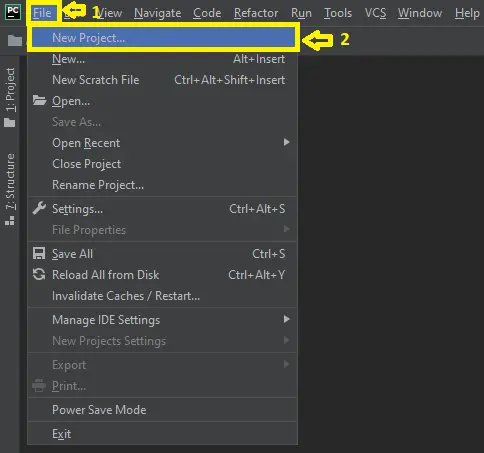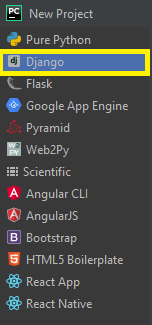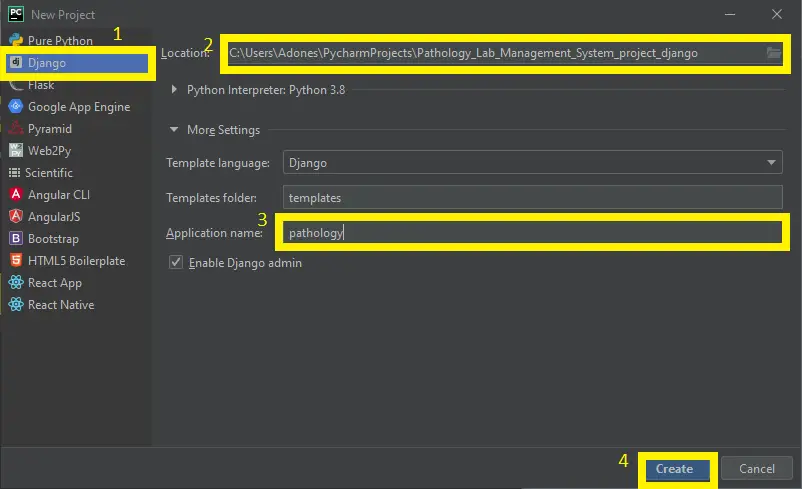Pathology Lab Management System Project in Django with Source Code
This Pathology Lab Management System Project in Django created based on python, Django, and MYSQL Database.
The major goal of this project is to create a website that provides users with on-the-fly capabilities for finding a patient’s test results.
This website allows users to obtain lab reports at any time. The goal of this application is to reduce the amount of human effort and time required to travel to a laboratory and obtain a test report, as well as to assist the administrator in maintaining the patient’s history.
A Pathology Lab Management System in Django is an easy project for beginners to learn how to build a web-based python Django project.
We will provide you with the complete source code and database for the python project so that you can easily install it on your machine and learn how to program in Python Django.
To start creating a Pathology Lab Management System Project in Python Django, makes sure that you have PyCharm Professional IDE Installed in your computer.
This Pathology Lab Management System in Django Framework includes a Download Source Code for free, just find the downloadable source code below and click download now.
Admin Features: Pathology Lab Management System in Django
- Register Agent Page– The page where the admin can create new agent.
- Login Page – The page where the system administrator enters their system credentials in order to gain access to the system’s administrative side.
- View Agent -This is the page where an administrator can view all new agent added.
- Remove Agent – This is the page where an administrator can remove agent information.
- Update Agent Profile – The page to which an administrator can update agent profile.
- View Leaves– The page where an administrator can view all agent who apply leaves.
| About Project | Project Details | Definition |
|---|---|---|
| Project Name | Pathology Lab Management System in Django | The Pathology Lab Management System is the most effective and quick reporting and EMR software available. The pathology center’s operations may be managed using an integrated, secure Web-based pathology management system. |
| Python version (Recommended) | 3.8 Version | Python 3.8 introduces some new syntax to the language, as well as a few small modifications to existing behavior and, most importantly, a slew of performance improvements, following in the footsteps of the previous 3.7 version. |
| Programming Language Used | Python Django Language | Django is a high-level Python web framework for building safe and maintainable websites quickly. Django is a web framework built by experienced developers that takes care of a lot of the heavy lifting so you can focus on developing your app instead of reinventing the wheel. |
| Developer Name | itsourcecode.com | Free projects containing source code in Java, PHP, Python, Django, VB.Net, Visual Basic, C, C++, C#, Javascript, and other languages are available on this website. |
| IDE Tool (Recommended) | Sublime, Visual Studio, PyCharm | Sublime Text is a source code editor that is available for purchase. It comes with built-in support for a variety of programming and markup languages. Plugins, which are often community-built and maintained under free-software licenses, allow users to extend the functionality of the system. Sublime Text has a Python API to help with plugins. |
| Project Type | Web Application | A web application, unlike computer-based software programs that operate locally on the device’s operating system, is application software that runs on a web server. The user uses a web browser with an active network connection to access web apps. |
| Database | SQLite | SQLite is a programming language that is used to create embedded software for devices such as televisions, cell phones, and cameras. It can handle HTTP requests with low to medium traffic. SQLite has the ability to compress files into smaller bundles with less metadata. SQLite is a temporary dataset that is used within an application to process data. |
Users Features: Pathology Lab Management System in Django
- Login Page – The page where the user administrator enters their system credentials in order to gain access to the system’s administrative side.
- Book a test -This is the page where the user can book a test.
- View Previous Test – This is the page where the user can view their previous test.
- Track a Test – This is the page where the user can track their test.
- Update Profile – The page where the user can update their own profile.
- Register Nominee – The page where the user can register a nominee.
- View Nominees – The page where the user can view all their nominees added.
Pathology Lab Management System in Django Steps on How to Create a Project
Time needed: 5 minutes
Here are the steps on how to create a Pathology Lab Management System Project in Django with Source Code.
- Step 1: Open file.
First , open “pycharm professional” after that click “file” and click “new project”.

- Step 2: Choose Django.
Next, after click “new project“, choose “Django” and click.

- Step 3: Select file location.
Then, select a file location wherever you want.

- Step 4: Create application name.
After that, name your application.

- Step 5: Click create.
Lastly, finish creating project by clicking “create” button.

- Step 6: Start Coding.
Finally, we will now start adding functionality to our Django Framework by adding some functional codes.
Functionality and Codes of the Pathology Lab Management System Project in Django with Source Code
- Create template for the agent registration form in Pathology Lab Management System in Django.
In this section, we will learn on how create a templates for the agent registration form. To start with, add the following code in your reg_agent.html under the folder of /templates/.
<!DOCTYPE html>
<html>
<head>
<title>Agent Reg.</title>
{% load static %}
<link rel="stylesheet" type="text/css" href="{% static 'login.css' %}" />
</head>
<body>
<center><h1>Pathology Lab Management</h1></center>
<center><div id="bar">
<a href="/labs/"><button class="button"><h2>Labs</h2> </button></a>
<a href="/centres/"><button class="button"><h2>Centres</h2></button></a>
<a href="/testnames/"><button class="button"><h2>Tests</h2></button></a>
<a href="/agentinfo/"><button class="button"><h2>Agents</h2> </button></a>
<a href="/contact/"><button class="button"><h2>Contact</h2> </button></a>
</div>
</center>
<br><br>
<center><h1>Agent Registration Form</h1></center>
<center>
{{ERROR}}
<br>
<form action="/admin_act/ag_regcheck/" method="POST">
{% csrf_token %}
ID:<br>
<input type="text" name="id" placeholder="ID" class="sform" id='IID'><br><br>
First Name:<br>
<input type="text" name="fname" placeholder="First Name" class="sform" id='fn'><br><br>
Last Name:<br>
<input type="text" name="lname" placeholder="Last Name"><br><br>
Date of Birth:<br>
<input type="text" name="dob" placeholder="YYYY-MM-DD" class="sform" id='db'><br><br>
Age:<br>
<input type="text" name="age" placeholder="Age"><br><br>
<input type="radio" name="gender" class="sbutton" value="Male"> Male <input type="radio" name="gender" class="sbutton" value="Female"> Female<br><br>
House No. : <input type="text" name="hno" class="sform" placeholder="House Number" id="hn"> Street : <input type="text" name="street" class="sform" placeholder="Street Name" id="st"><br><br>
Locality : <input type="text" name="local" class="sform" placeholder="Locality" id="lc"> Landmark : <input type="text" name="lmark" placeholder="Landmark"><br><br>
Address Line : <input type="text" name="addline" placeholder="Address Line"><br><br> City : <input type="text" name="city" class="sform" placeholder="City" id="ct"><br><br>
State : <input type="text" name="state" class="sform" placeholder="State" id="state"><br><br> PINCODE : <input type="text" name="pin" placeholder="pincode" ><br><br>
Phone Number:<br>
<input type="text" name="phno" placeholder="Phone Number" class="sform" id="ph"><br><br>
Email ID:<br>
<input type="email" name="eid" placeholder="Email ID" class="sform"><br><br>
Password:<br>
<input type="password" name="passwd" placeholder="Password" class="sform"><br><br>
Re-Password:<br>
<input type="password" name="repwd" placeholder="Re-Password" class="sform"><br>
<input type="submit" name="enter" placeholder="SUBMIT">
</form>
</center><br><br>
<center><a href="/admin_act/menu/" ><button class="button1">Go To Menu</button></a></center><br><br>
<center><a href="/admin_act/sign_out/" ><button class="sign">Sign Out</button></a></center>
</body>
</html>- Create template for the sign up form in Pathology Lab Management System in Django.
In this section, we will learn on how create a templates for the sign up form. To start with, add the following code in your sign_up.html under the folder of /templates/.
<!DOCTYPE html>
<html>
<head>
<title>Sign Up</title>
{% load static %}
<link rel="stylesheet" type="text/css" href="{% static 'login.css' %}" />
</head>
<body>
<center><h1>Pathology Lab Management</h1></center>
<center><div id="bar">
<a href="/labs/"><button class="button"><h2>Labs</h2> </button></a>
<a href="/centres/"><button class="button"><h2>Centres</h2></button></a>
<a href="/testnames/"><button class="button"><h2>Tests</h2></button></a>
<a href="/agentinfo/"><button class="button"><h2>Agents</h2> </button></a>
<a href="/contact/"><button class="button"><h2>Contact</h2> </button></a>
</div>
</center>
<br><br>
<center><h1>Sign Up Form</h1></center>
<center>
{{ERROR}}
<br>
<form action="/login/new_check/" method="POST">
{% csrf_token %}
ID:<br>
<input type="text" name="id" placeholder="ID" class="sform" id='IID'><br><br>
First Name:<br>
<input type="text" name="fname" placeholder="First Name" class="sform" id='fn'><br><br>
Last Name:<br>
<input type="text" name="lname" placeholder="Last Name"><br><br>
Date of Birth:<br>
<input type="text" name="dob" placeholder="YYYY-MM-DD" class="sform" id='db'><br><br>
Age:<br>
<input type="text" name="age" placeholder="Age"><br><br>
<input type="radio" name="gender" class="sbutton" value="Male"> Male <input type="radio" name="gender" class="sbutton" value="Female"> Female<br><br>
House No. : <input type="text" name="hno" class="sform" placeholder="House Number" id="hn"> Street : <input type="text" name="street" class="sform" placeholder="Street Name" id="st"><br><br>
Locality : <input type="text" name="local" class="sform" placeholder="Locality" id="lc"> Landmark : <input type="text" name="lmark" placeholder="Landmark"><br><br>
Address Line : <input type="text" name="addline" placeholder="Address Line"><br><br> City : <input type="text" name="city" class="sform" placeholder="City" id="ct"><br><br>
State : <input type="text" name="state" class="sform" placeholder="State" id="state"><br><br> PINCODE : <input type="text" name="pin" placeholder="pincode" ><br><br>
Phone Number:<br>
<input type="text" name="phno" placeholder="Phone Number" class="sform" id="ph"><br><br>
Email ID:<br>
<input type="email" name="eid" placeholder="Email ID" class="sform"><br><br>
Password:<br>
<input type="password" name="passwd" placeholder="Password" class="sform"><br><br>
Re-Password:<br>
<input type="password" name="repwd" placeholder="Re-Password" class="sform"><br>
<input type="submit" name="enter" placeholder="SUBMIT">
</form>
</center>
<center>
<a href='/login/red_home/'><button class='button1'>GO HOME</button></a>
</center>
</body>
</html>- Create template for the Test Booking Form in Pathology Lab Management System in Django.
In this section, we will learn on how create a templates for the Test Booking Form. To start with, add the following code in your book_test.html under the folder of /templates/.
<!DOCTYPE html>
<html>
<head>
<title>Book A Test</title>
{% load static %}
<link rel="stylesheet" type="text/css" href="{% static 'login.css' %}" />
</head>
<body>
<center><h1>Pathology Lab Management</h1></center>
<center><div id="bar">
<a href="/labs/"><button class="button"><h2>Labs</h2> </button></a>
<a href="/centres/"><button class="button"><h2>Centres</h2></button></a>
<a href="/testnames/"><button class="button"><h2>Tests</h2></button></a>
<a href="/agentinfo/"><button class="button"><h2>Agents</h2> </button></a>
<a href="/contact/"><button class="button"><h2>Contact</h2> </button></a>
</div>
</center>
<br><br>
<center><h1>Test Booking Form</h1></center>
<br><br>
<center>{{MSG}}</center>
<center>
<form action='/user/book_submit/' method="POST">
{% csrf_token %}
<h4><p>Lab and Test ID:<br></p></h4>
<select name='lt' style="width: 30%">
<option disabled> -Select</option>
{% for i in lts %}
<option value={{ i.0 }} name="ltid">{{ i.0 }}</option>
{% endfor %}
</select><br><br>
<h4><p>Patient ID:<br></p></h4>
<select name="pati" style="width: 30%">
<option disabled> -Select</option>
{% for i in pat %}
<option value={{ i.0 }} name="pat">{{ i.0 }}</option>
{% endfor %}
</select><br><br>
<input type="radio" name="samp" value="home"> Home Collection
<input type="radio" name="samp" value="venue"> Collection Centre
<br><br>
<h4><p>Collection City:<br></p></h4>
<select name='ct' style="width: 30%">
<option disabled> -Select</option>
{% for i in city %}
<option value={{ i.0 }} name="city">{{ i.0 }}</option>
{% endfor %}
</select><br><br>
<h4>Test Date: </h4>
<input type="date" min={{ min }} max={{ max }} name="ndate"><br><br>
<input type="submit" name="submit" value="BOOK">
</form>
</center>
<br><br>
<center><a href="/user/menu/" ><button class="button1">Go To Menu</button></a></center><br><br>
<center><a href="/user/sign_out/" ><button class="sign">Sign Out</button></a></center>
</body>
</html>Downloadable Source Code Below.
Anyway, if you want to level up your programming knowledge, especially python, try this new article I’ve made for you Best Python Projects with source code for Beginners.
But If you’re going to focus on web development using Django, you can download here from our list of Best Django Projects with source code based on real-world projects.
How To Run The Pathology Lab Management System in Django?
- Step 1: Extract/unzip the file
- Step 2: Go inside the project folder, open cmd and type the following commands to install Django Framework and run the webserver:
- python manage.py migrate
- python manage.py runserver
- Step 3: Finally, open the browser and go to http://127.0.0.1:8000/
Summary
In summary, the Pathology Lab Management System in Django with Source Code can be useful to students or professional who wants to learn python programming language.
This project can also be modified to fit your personal requirements. Hope this project will help you to improve your skills. Happy Coding!
- How To Make A Point Of Sale System In Python
- Best Python Projects for Beginners
- Python MySQL Connection: Simple Python Step by Step Guide
- Python PIP Command Set-up / Fix: Step by Step Guide
- Random Password Generator in Python Projects With Source Code
- Python Range Function|Range in Python Explained with Examples
- School Management System Project In Django With Source Code
- Django Login And Registration With Source Code
- CRUD App In Django With Source Code
- Drag And Drop JavaScript With Source Code
- Todo List App Django With Source Code
Inquiries
If you have any questions or suggestions about Pathology Lab Management System in Django with Source Code, please feel free to leave a comment below.





